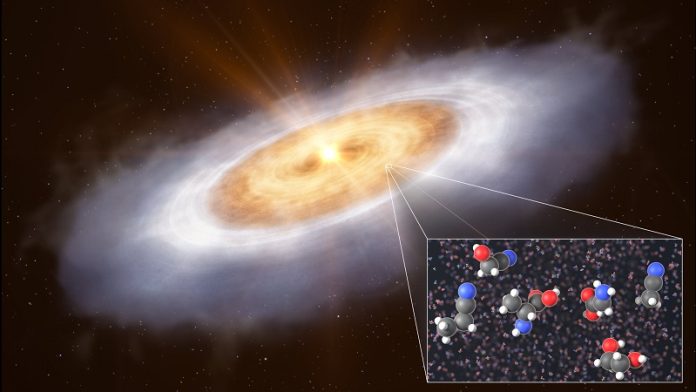
In a groundbreaking discovery, astronomers have found complex organic molecules—key ingredients for life—around a young star known as V883 Orionis.
Using the powerful ALMA telescope in Chile, researchers detected 17 complex molecules in the swirling disk of gas and dust that surrounds the star.
These include ethylene glycol, commonly used in antifreeze, and glycolonitrile, a molecule linked to the formation of amino acids and DNA bases.
This discovery, published in The Astrophysical Journal Letters, suggests that the chemical seeds of life are not unique to Earth and may actually be common in space.
These complex organic molecules, known as COMs, contain more than five atoms and are thought to be essential for forming amino acids, sugars, and the building blocks of DNA and RNA.
The team, led by Abubakar Fadul from the Max Planck Institute for Astronomy, found that these molecules likely didn’t form in the current disk alone.
Instead, they may have been created earlier—before the star and its disk even fully formed—and then carried forward.
This challenges the earlier belief that energetic activity around a new star would destroy these fragile molecules, requiring them to be rebuilt from scratch.
Instead, it now appears that these molecules can survive the star’s violent early years and even continue forming during this phase.
Stars like V883 Orionis are still growing by pulling in gas from their surroundings.
During this process, the star can erupt with bursts of energy that heat up the surrounding disk, including its icy regions. This heating causes the ice to vaporize, releasing previously hidden chemicals into space, where they can be detected by instruments like ALMA.
Ethylene glycol and glycolonitrile both emit signals in radio wavelengths, which ALMA is well-equipped to detect. The telescope, located high in the Atacama Desert, allows scientists to pinpoint faint chemical fingerprints from far-off objects like V883 Orionis.
Interestingly, the way these molecules are released in this star system is similar to how comets in our own solar system heat up and release gases when they pass close to the sun.
This similarity supports the idea that planets—including Earth—may have inherited the ingredients for life from the very earliest stages of star and planet formation.
The team hopes that future, higher-resolution data will confirm these early findings and possibly uncover even more complex molecules. According to Fadul and his colleagues, we are only beginning to understand how and where the building blocks of life may form in the universe.



